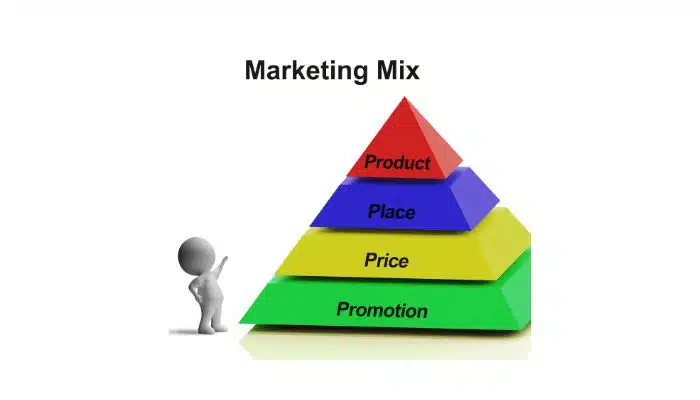In business, the ability to understand and implement effective strategies is essential to stand out in a saturated and constantly evolving marketplace. In this context, the Marketing Mix emerges as a fundamental tool, acting as the strategic map that guides companies towards success.
From the traditional 4Ps (Product, Price, Place and Promotion) to the modern expansions that include People, Process and Physical Evidence, we will explore each aspect of the Marketing Mix in depth.
Learn how these strategies not only intertwine with each other, but also how their intelligent application can make the difference between resounding success and stagnation.
That is why we give you a complete guide that will allow you not only to understand their essential components, but also to master the ability to combine them synergistically to maximize their impact on the market.
What is the marketing mix?
The Marketing Mix, also known as the 4Ps, is a set of fundamental strategies and tactics that companies use to market and position their products or services in the marketplace. These strategies were first proposed by Professor Jerome McCarthy in the 1960s and later expanded by Philip Kotler.
Likewise, the Marketing Mix is a strategic tool that allows companies to comprehensively address the different aspects that influence the marketing of their products or services, adapting to the needs of the market and maximizing their effectiveness.
What is the marketing mix for?
These are some of the functions of the marketing mix:
- Integrated strategy development: Provides a framework for the development of integrated and coherent marketing strategies. By considering all four variables simultaneously, companies can create a complete and balanced approach.
- Customer satisfaction: Focuses on understanding and satisfying customer needs. By designing attractive products, setting appropriate prices, distributing and promoting them effectively, we seek to improve customer satisfaction.
- Market differentiation: Allows companies to differentiate themselves from the competition by adjusting each variable in a unique way. The combination of product, price, distribution and promotion contributes to the creation of a unique identity in the market.
- Resource optimization: Facilitates the efficient allocation of resources by allowing companies to focus on the most effective areas to achieve their objectives. Helps avoid wasting resources in other areas.
- Market adaptability: Can adapt to changes in the market, consumer preferences and competition. This allows companies to be agile and adjust their strategy as needed to remain competitive.
- Improved profitability: By balancing variables, companies can improve their profitability. Proper pricing, efficient distribution management and effective promotion can increase sales and profit margins.
- Brand building and loyalty: Contributes to building and maintaining strong brands and long-term customer relationships. Consistency in marketing mix strategies helps build brand identity and foster customer loyalty.
- Informed decision making: Provides a logical framework for marketing decision making. Managers can evaluate and adjust each P individually to achieve the company’s objectives.
Elements of the Marketing Mix
The Marketing Mix is composed of four key elements, which are the 4Ps: Product, Price, Place (or distribution) and Promotion.
- Product: This element refers to the good or service that the company offers to its customers. It includes the quality, design, features and brand of the product.
- Price: The amount of money that customers must pay for the product or service. Setting the right price is crucial, as it affects the customer’s perception of value and the company’s profitability.
- Place: This aspect focuses on the distribution and availability of the product. It includes the choice of distribution channels, the location of points of sale and logistics to ensure that the product reaches consumers efficiently.
- Promotion: Refers to the marketing and communication strategies used to publicize the product and persuade customers to buy it. Includes advertising, public relations, sales promotions and digital marketing.
For this reason, over time, additional elements have been added to the Marketing Mix, extending it to 7P, incorporating People, Process and Physical Evidence, especially relevant in the provision of services.
Keys to a successful marketing mix strategy
A successful marketing mix strategy requires careful planning and effective execution of the 4 Ps: Product, Price, Place and Promotion. Here are some keys to developing a successful marketing mix strategy:
Knowledge of the client:
- Understand the needs, wants and behaviors of your target audience.
- Conducts market research to obtain valuable information on customer perception and market trends.
2. Integration of the 4 Ps:
- Ensure that Product, Price, Place and Promotion strategies are aligned and mutually reinforcing.
- Consistency in product presentation and promotional messages.
3. Focus on customer value:
- Highlight the value your product or service brings to customers.
- Consider how you can differentiate your offering so that it is perceived as unique and valuable.
4. Strategic pricing:
- Set prices that reflect the value perceived by customers.
- It considers factors such as costs, competition and elasticity of demand when setting prices.
5. Efficient distribution channel:
- Select distribution channels that efficiently reach your target market.
- Make sure products are available in the right places at the right time.
6. Effective promotion:
- Use promotional strategies that resonate with your audience.
- Incorporates digital marketing tactics, social media and other modern forms of promotion.
7. Continuous monitoring and adaptation:
- Regularly monitor the performance of your strategy.
- Adjust your approach according to changes in the market, competition and customer preferences.
8. Constant innovation:
- Stay on top of market trends and constantly look for ways to improve.
- Introduces innovations in products, services or processes to maintain freshness and relevance.
9. Focus on customer experience:
- Delivers a positive experience at all customer touch points.
- Customer satisfaction contributes to loyalty and positive word-of-mouth.
10. Evaluation of results:
- Establish key performance indicators (KPIs) and regularly measure results.
- Analyze the effectiveness of each component of the marketing mix and adjust as necessary.
It should be noted that the key is flexibility and adaptability. Successful strategies are not static, but evolve to meet changing market conditions and customer needs. In addition, being willing to learn from past successes and failures is essential to continually improve your marketing mix strategy.
Examples of successful marketing mix
Coca-Cola:
- Product: Coca-Cola has diversified its product line with options such as Coca-Cola Zero, Diet Coke, and other non-carbonated beverages.
- Price: Pricing strategy based on the perception of value, with premium options and more accessible products.
- Plaza: Global distribution through an extensive network of retailers and points of sale.
- Promotion: Global advertising campaigns, event sponsorship and celebrity partnerships.
Apple iPhone:
- Product: Innovative design, advanced technology, and periodic launch of new models.
- Price: Premium pricing strategy to reflect the quality and exclusivity of the product.
- Location: Sold through Apple’s own stores, wireless carriers and authorized resellers.
- Promotion: Attractive advertising, highly anticipated product launches, and association with celebrities.
McDonald’s:
- Product: Diversified menu, including options for different market segments.
- Pricing: Competitive pricing strategy and combo offers to attract customers.
- Plaza: Global presence with restaurants in strategic locations, both in urban areas and in shopping malls.
- Promotion: Traditional and digital media advertising, local promotions and event-based campaigns.
4. Nike:
- Product: High-quality sports shoes, clothing and sports equipment.
- Price: Premium pricing strategy for performance products, but also offer more affordable options.
- Plaza: Distribution through own stores, retailers, and online presence.
- Promotion: Sponsorship of renowned athletes, emotional marketing campaigns and activation in social networks.
Starbucks:
- Product: Variety of coffee beverages, food and related products.
- Price: Premium pricing strategy for specialty beverages, but with more accessible options.
- Plaza: Strategic location of stores in urban areas, shopping malls and airports.
- Promotion: Loyalty program (Starbucks Rewards), seasonal promotions and participation in social networks.
These examples illustrate how companies apply different marketing mix strategies to suit their specific products, markets and objectives. Each component of the marketing mix is fine-tuned to create a comprehensive strategy that drives success in the marketplace.
If you need help, guidance or support in any aspect related to the area of digital marketing and web development, in Kiwop we are at your disposal. Our team of highly trained professionals is ready to provide you with customized solutions that fit your needs and objectives.




Leave a Reply